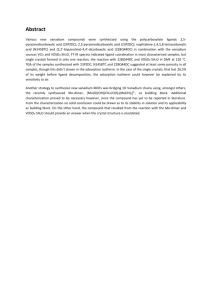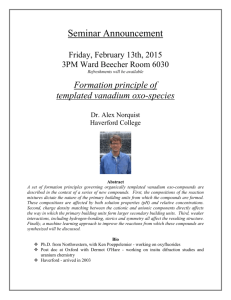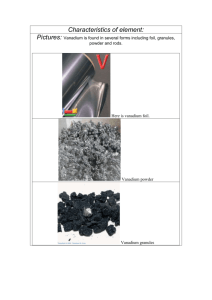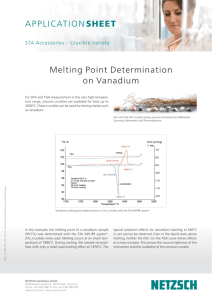Document 13308579
advertisement
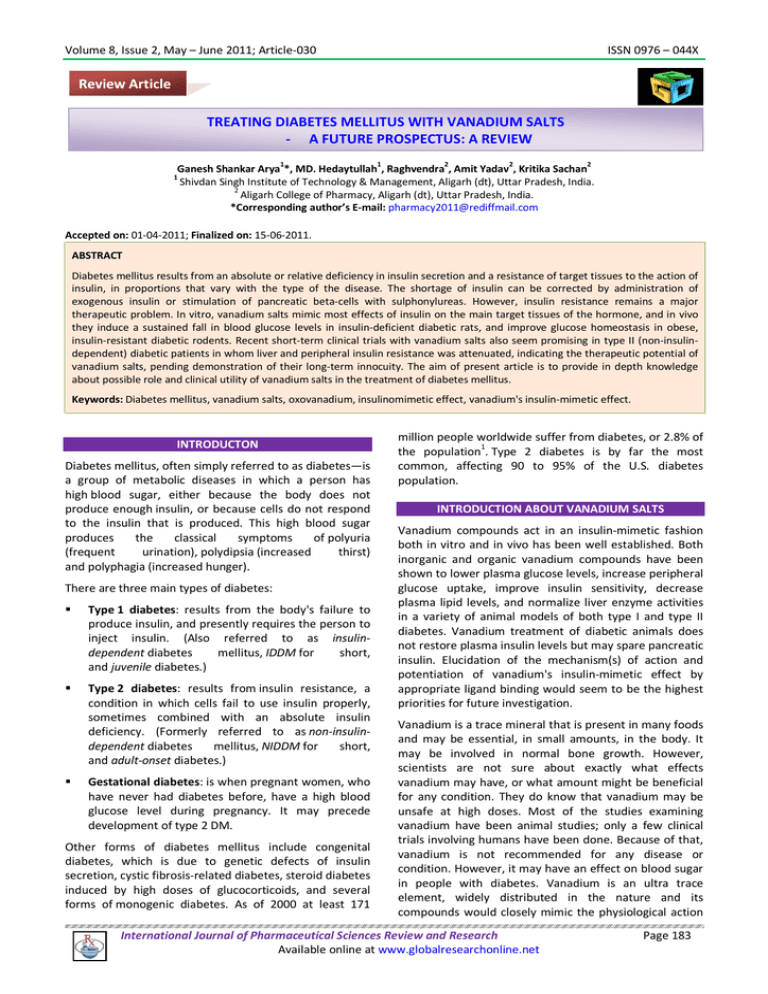
Volume 8, Issue 2, May – June 2011; Article-030 ISSN 0976 – 044X Review Article TREATING DIABETES MELLITUS WITH VANADIUM SALTS - A FUTURE PROSPECTUS: A REVIEW 1 1 2 2 2 Ganesh Shankar Arya *, MD. Hedaytullah , Raghvendra , Amit Yadav , Kritika Sachan Shivdan Singh Institute of Technology & Management, Aligarh (dt), Uttar Pradesh, India. 2 Aligarh College of Pharmacy, Aligarh (dt), Uttar Pradesh, India. *Corresponding author’s E-mail: pharmacy2011@rediffmail.com 1 Accepted on: 01-04-2011; Finalized on: 15-06-2011. ABSTRACT Diabetes mellitus results from an absolute or relative deficiency in insulin secretion and a resistance of target tissues to the action of insulin, in proportions that vary with the type of the disease. The shortage of insulin can be corrected by administration of exogenous insulin or stimulation of pancreatic beta-cells with sulphonylureas. However, insulin resistance remains a major therapeutic problem. In vitro, vanadium salts mimic most effects of insulin on the main target tissues of the hormone, and in vivo they induce a sustained fall in blood glucose levels in insulin-deficient diabetic rats, and improve glucose homeostasis in obese, insulin-resistant diabetic rodents. Recent short-term clinical trials with vanadium salts also seem promising in type II (non-insulindependent) diabetic patients in whom liver and peripheral insulin resistance was attenuated, indicating the therapeutic potential of vanadium salts, pending demonstration of their long-term innocuity. The aim of present article is to provide in depth knowledge about possible role and clinical utility of vanadium salts in the treatment of diabetes mellitus. Keywords: Diabetes mellitus, vanadium salts, oxovanadium, insulinomimetic effect, vanadium's insulin-mimetic effect. INTRODUCTON Diabetes mellitus, often simply referred to as diabetes—is a group of metabolic diseases in which a person has high blood sugar, either because the body does not produce enough insulin, or because cells do not respond to the insulin that is produced. This high blood sugar produces the classical symptoms of polyuria (frequent urination), polydipsia (increased thirst) and polyphagia (increased hunger). There are three main types of diabetes: Type 1 diabetes: results from the body's failure to produce insulin, and presently requires the person to inject insulin. (Also referred to as insulindependent diabetes mellitus, IDDM for short, and juvenile diabetes.) Type 2 diabetes: results from insulin resistance, a condition in which cells fail to use insulin properly, sometimes combined with an absolute insulin deficiency. (Formerly referred to as non-insulindependent diabetes mellitus, NIDDM for short, and adult-onset diabetes.) Gestational diabetes: is when pregnant women, who have never had diabetes before, have a high blood glucose level during pregnancy. It may precede development of type 2 DM. Other forms of diabetes mellitus include congenital diabetes, which is due to genetic defects of insulin secretion, cystic fibrosis-related diabetes, steroid diabetes induced by high doses of glucocorticoids, and several forms of monogenic diabetes. As of 2000 at least 171 million people worldwide suffer from diabetes, or 2.8% of the population1. Type 2 diabetes is by far the most common, affecting 90 to 95% of the U.S. diabetes population. INTRODUCTION ABOUT VANADIUM SALTS Vanadium compounds act in an insulin-mimetic fashion both in vitro and in vivo has been well established. Both inorganic and organic vanadium compounds have been shown to lower plasma glucose levels, increase peripheral glucose uptake, improve insulin sensitivity, decrease plasma lipid levels, and normalize liver enzyme activities in a variety of animal models of both type I and type II diabetes. Vanadium treatment of diabetic animals does not restore plasma insulin levels but may spare pancreatic insulin. Elucidation of the mechanism(s) of action and potentiation of vanadium's insulin-mimetic effect by appropriate ligand binding would seem to be the highest priorities for future investigation. Vanadium is a trace mineral that is present in many foods and may be essential, in small amounts, in the body. It may be involved in normal bone growth. However, scientists are not sure about exactly what effects vanadium may have, or what amount might be beneficial for any condition. They do know that vanadium may be unsafe at high doses. Most of the studies examining vanadium have been animal studies; only a few clinical trials involving humans have been done. Because of that, vanadium is not recommended for any disease or condition. However, it may have an effect on blood sugar in people with diabetes. Vanadium is an ultra trace element, widely distributed in the nature and its compounds would closely mimic the physiological action International Journal of Pharmaceutical Sciences Review and Research Available online at www.globalresearchonline.net Page 183 Volume 8, Issue 2, May – June 2011; Article-030 of insulin by initial entry into the portal system. This mini review summarized the latest advancements in this field, considering the vanadium compounds effective in organic or inorganic forms. The major concern related to the use of vanadium salts is the safety profile. Vanadate has insulin-like effects on the metabolism of glucose both in vivo and in vitro in various tissues. Vanadium salts such as Na 3 VO 4, NaVO 3, VOSO 4, VO (acac)2, and VO (Et-acac) 2 mimic several of the metabolic and growth-promoting effects of insulin. Some traditional medicines from a number of plants and plant products with antidiabetic activity also show great promise. Some studies have suggested that vanadium compounds help to normalize blood glucose levels in people with both type I and type II diabetes. Vanadium, atomic number 23, atomic weight 50.94, is a first-row transition metal that shows a wide range of oxidation states in monomeric, oligomeric, and polymeric species in solution. It exists in oxidation states of −I, 0, +II, +III, +IV, and +V; the latter two are stable solution structures at physiological pH: vanadyl (+IV) and vanadate (+V). The oral administrations of inorganic vanadium (IV, V) salts have shown anti-diabetic activity2,3,4. Vanadium compounds show insulin-like effects in vivo and in vitro. Several clinical studies have shown the efficacy of vanadium compounds in type 2 diabetic subjects. Orally administrated sodium vanadate has been reported to improve DM in human diabetes before the discovery of insulin and its clinical use to treat DM has been previously demonstrated. Vanadium compounds have been shown to be effective in animal models such as spontaneously diabetic (BB) rats and insulin-resistant Zucker fa/fa rats and recently in human trials5. An overview on vanadium salts Vanadium salts being used as a metallotherapeutic appeared in 18996. Early interest in vanadium as a metallotherapeutic waned, even as the exploration of vanadium's biological effects in plants and animals continued. The discovery that vanadium (V), as vanadate, was an extremely potent enzymatic inhibitor was completely unanticipated. A number of laboratories world-wide had noticed that a particular commercial preparation of ATP (from Sigma Chemical Co.) gave anomalously low catalytic rates in a standard ATPase assay7. But safety, tolerability, pharmacokinetics, and bioavailability of escalating doses of a vanadium complex for therapeutic use in diabetic mellitus were assessed in 20038. But, later vanadium-based hypoglycaemic agents appeared in the market as vitamin and mineral supplements. Since 1922, after the discovery of 9 insulin , various observations have been made on vanadium's ubiquitous nature and pharmacological effect that led to a series of clinical trials in humans which proved its role as a potential cholesterol-lowering pharmaceutical agent. Vanadium is an essential trace element of unknown function in cellular regulation and an indigenous constituent of most mammalian tissues. ISSN 0976 – 044X Vanadate has insulin-like effects on the metabolism of glucose both in vivo and in vitro in various tissues. Vanadium salts such as Na 3 VO 4, NaVO 3, VOSO 4, VO (acac) 2, and VO (Et-acac) 2 mimic several of the metabolic and growth-promoting effects of insulin. Today the scientific strategies to overcome the barriers to oral insulin administration are also underway with the use of permeation enhancers, protease inhibitors, enteric coatings, polymer microsphere formulations, and drug delivery techniques. With the help of this brief authors effort for identifying and developing specific vanadium compounds for insulin mimic in present scenario. Vanadium salts like sodium orthovanadate, sodium metavanadate, and vandyl sulfate have action like insulin and they lower blood glucose levels in various animal models and have potential as hypoglycaemic agents10, 11. Recently, vanadium salts like VO(acac)2 and VO(Et-acac)2 have been reported to have in vivo insulin-like effects in diabetic Wistar rats. Further, the organic form of vanadium is recognized as safer and more absorbable, and able to deliver a therapeutic effect; as a result, numerous organic complexes of vanadium have been developed12, 13. Possible side effects of vanadium In vitro studies showed that vanadium ions may promote genetic alterations and have mitogenic effects in cultured cells14, 15. In animal studies, vanadium was deposited in bone but did not appear to affect bone strength or architecture. Toxicity has been observed in animals at high dosages. One study reported increases weight loss and mortality in diabetic rats treated with vanadium16. Discussions, summary and future research directions Vanadium compounds for treatment of diabetes are now on the threshold of becoming a practical alternative to other oral hypoglycaemic agents. The therapeutic potential has been repeatedly demonstrated, the mechanism is now accepted as being multifactorial, and the serum protein, transferrin, has been identified as the most likely circulatory transport protein for absorbed vanadium ions. Some studies have suggested that vanadium compounds help to normalize blood glucose levels in people with both type I and type II diabetes. Many organovanadium compounds have been reported to exert potent insulinomimetic effects both in vitro and in vivo. In vitro data show that vanadium has insulinomimetic properties, including stimulation of glucose uptake, glycogen synthesis, and glucose oxidation. Vanadium obviously has the potential to affect many areas in the body for better or worse. The most significant research on vanadium to date involves its insulin-like properties and its possible role in treating diabetes. Further, research is required for the development of oral formulations in human beings. There is also a need to work on the natural resources containing International Journal of Pharmaceutical Sciences Review and Research Available online at www.globalresearchonline.net Page 184 Volume 8, Issue 2, May – June 2011; Article-030 ISSN 0976 – 044X inhibitor found in ATP derived from muscle, J Biol Chem, 252, 1977, 7421-7423. vanadium elements which can be utilized as a dietary supplement helpful in managing diabetic patients. Acknowledgement: The authors are thankful to the management of Shivdan Singh Institute of Technology & Management, Aligarh, for providing facilities to utilize the library and internet in the college. REFERENCES 1. Wild S, Roglic G, Green A, Sicree R, King H, "Global prevalence of diabetes: estimates for 2000 and projections for 2030", Diabetes Care, 27 (5), 2004, 1047–1053. 2. Lu B, Ennis D, Lai R, Bogdanovic E, Enhanced sensitivity of insulin-resistant adipocytes to vanadate is associated with oxidative stress and decreased reduction of vanadate (+5) to vanadyl (+4), J Biol Chem, 276 (35), 2001, 589-598. 3. Semiz S, Orvig C, McNeill JH, Effects of diabetes, Vanadium, and insulin on glycogen synthase activation in Wistar rats, Mol Cell Biochem, 231, 2002, 23-35. 4. Goldfine AB, Simonson DC, Folli F, In vivo and in vitro studies of vanadate in human and rodent diabetes mellitus, Mol Cell Biochem, 153, 1995, 217-31. 8. Thompson KH, Orvig C, Metal complexes in medicinal chemistry: new vistas and challenges in drug design, Dalton Trans, 6, 2006, 761-764. 9. Banting FG, Best CH, Collip JB, Campbell WR, Fletcher AA, Pancreatic extracts in the treatment of diabetes mellitus, Can Med Assoc J, 12, 1922, 141-146. 10. Ramasarma T, Crane FL, Does vanadium plays a role in cellular regulation? Curr Top Cell Reg, 20, 1981, 247-301. 11. Nechay BR, Mechanisms of action of vanadium, Ann Rev Pharmacol Toxico, 24, 1984, 501-503 12. Baldmaev V, Prakash S, Majeed M, Vanadium: A review of its potential role in the fight against diabetes, J Altern Complement Med, 5, 1999, 273-291. 13. Storr T, Mitchell D, Buglyo P, Thompson KH, Yuen VG, McNeill JH, et al, Vanadyl-Thiazolidinedione combination agents for diabetes therapy, Bio conjugate Chem, 14, 2003, 212-221. 14. Owuso-Yaw J, Cohen SY, Wei CI, An assessment of the genotoxicity of vanadium, Toxicol Lett, 50, 1990, 327-336. 5. Boden G, Chen X, Ruiz J, van Rossum GD, Turco S, Effects of vanadyl sulfate on carbohydrate and lipid metabolism in patients with non-insulin-dependent diabetes mellitus, Metabolism, 45, 1996,1130-1135. 15. Sabbioni E, Pozzi g, Pintar A, et al, Cellular reactions, cytotoxicity and morphological transformation by vanadium (IV) and vanadium (V) in BALB/3T3 cell linbes, Carcinogenesis, 12, 1991, 47-52. 6. Lyoonnet B, Martz M, Martin E. L, employ therapeutique des derives du Vanadium, La Presse Med, 1899, 32, 191192. 7. Cantley LC Jr, Josephson L, Warner R, Yanagisawa M, Lechene C, Guidotti G, Vanadate is a potent (Na, K)-ATPase 16. Domingo JL, Gomez , Llobet JM, et al, Oral Vanadium administration to streptozotocin-diabetic rats has marked negative side effects which are independent of the from of vanadium used, Toxicology, 66, 1991, 279-287. About Corresponding Author: Mr. Ganesh Shankar Arya Mr. Ganesh Shankar Arya graduated at Uttar Pradesh Technical University, Lucknow, U.P, India and at post graduation level, had taken specialization in Pharmaceutics from Dr. M.G.R. Medical University, Chennai, Tamil Nadu, India. Now working as a Senior Lecturer in Shivdan Singh Institute of Technology & Management, Aligarh, Uttar Pradesh, India-202001. International Journal of Pharmaceutical Sciences Review and Research Available online at www.globalresearchonline.net Page 185
